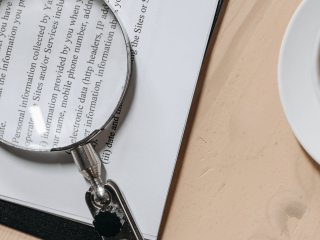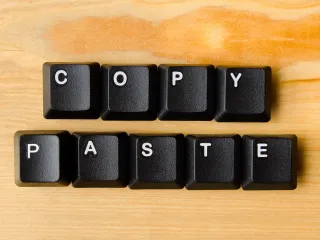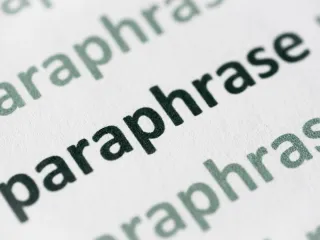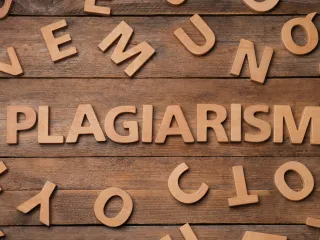Plagiarism on the Internet: What to Watch For When Selecting Sources
The internet is no longer in its infancy, and with its permeation of every aspect of society, it has brought sweeping changes to each industry and human endeavor. This is as true for writing as it is for any other field, whether you’re talking about professionals or students. One of those effects is that the internet has made plagiarism much easier. With the availability of search engine results, which can turn up millions of hits on almost any subject, it is now easier than ever to commit academic dishonesty.
On the other hand, the internet has also made it much easier to detect plagiarists. The prevalence of tools that can compare documents and find cheaters has created a kind of arms race between those who care about academic integrity and those who care about wrapping up a boring assignment quickly. (To be clear, we’re in the academic integrity camp, even for boring assignments.)
Internet plagiarism is a serious problem. Below, we will consider what plagiarism looked like before the internet, what it looks like now, and a definition of plagiarism. We will also discuss technology and plagiarism, specifically as regards pedagogy and the professional world. Lest you think it’s all bad news, we will also talk about plagiarism checker tools and what you can do to steer clear of academic dishonesty.
Plagiarism Before the Internet
Before the internet, plagiarism in academic writing or as a professional writer was much easier to pull off. It was simple to find sources that other people hadn’t heard of, and it was nearly impossible to detect. The average incidence of plagiarism detection in a sentence, paragraph, essay, or book was low – with predictable effects on honor codes and learners. Today, the problem of plagiarism is much more widespread.
Ease of Plagiarism Today
Internet plagiarism has taken things to a whole new level. Internet plagiarism, in a nutshell, it’s when a writer “borrows” content from an online source and uses it in their paper as though it is theirs. They may copy word for word, use paraphrasing, rearrange words and paragraphs, or simply use ideas without credit.
Unfortunately, the internet has a nearly limitless supply of articles that could be plagiarized. With the rise of online writing services that will do your homework for you – also extremely difficult to detect – plagiarism on the internet is rampant. Not only is student plagiarism found frequently, but it’s seen in the professional community as well.
Understanding the internet plagiarism definition is only part of the problem, however. While you can’t do anything about paper mills in the internet era, professionals, college students and high school students can be sure to stay on the right side of history. The first step to combatting the plague of plagiarism and the internet is to make sure they’re not being plagiarists themselves.
How to Detect Plagiarism
Plagiarism affects everyone in school, higher education, and the professional world. The simple truth that you can never be sure if a search engine is returning an honest result is unsettling. All you can do is make sure you’re not violating ethics, and the best way to do this is by avoiding plagiarism in your own papers. This involves several steps:
- When writing the essay, be sure you always prioritize your own ideas in the outlining and writing phase. Never put other people’s work first or lean on it too heavily. Instead, write out everything in your own words first, then insert supporting arguments from your sources.
- Be sure to put quotation marks around all word-for-word quotes you use. If the writing style you’re using (APA, MLA, or Chicago) requires you to use block quotes for longer passages, do so. That way, anyone reading your paper will know that those ideas belong to someone else.
- Cite your sources carefully. It’s not enough to only use quote marks; you have to indicate who said the idea originally so that they get credit. This is a pillar of academic ethics. Careful citing is a surefire way to indicate to professors, bosses, and other authority figures that you have no intention of joining the ranks of the cheaters. Be sure to use both in-text citations and footnotes, as well as a works cited or bibliography page. If you’re not sure which to use, ask, or consult a citation style guide.
- The best way to avoid plagiarism on the whole is by going through the paper yourself first to see if your ideas match up and if you’ve attributed borrowed ideas correctly. Afterward, you can use plagiarism detection tools to ensure you haven’t accidentally failed to credit a proper source.
Luckily, plagiarism detection is relatively simple when you employ a tool designed for just that.
Using a Plagiarism Checker
Although some misuse it, the use of the internet is a gift to the modern age—especially for writers and researchers. The best way to respect that gift is to make sure you’re writing as justly as you can. That way, you’re contributing meaningful information to the body of human work rather than taking it from someone else.
That’s exactly what plagiarism checkers allow you to do. They scan for academic honesty and protect intellectual property all in one fell swoop. Often, students cheat because they simply don’t know they’re doing it, but school staff will never treat that as an innocent mistake. Academic consequences for plagiarism can include automatically receiving a zero on the assignment, failing the course, and occasionally even suspension. From a term paper to a blog post to a book, plagiarism must be avoided at all costs.
With a checker tool, students’ work becomes increasingly more reliable. Plagiarism checkers compare your paper against the millions and millions of other documents available online. If it finds any discrepancies, it will point them out to you, so you can see what happened. Then, you have the option to create a citation quickly and easily, in the appropriate style.
Sources and Citations
In addition to changing the plagiarism landscape, the internet has also changed how sources are found and cited. Now, there exist any number of sources of which we couldn’t even dream before the internet age, such as:
- Facebook posts, LinkedIn posts, Instagram reels, tweets, and other social media content
- Online articles and periodicals
- Blog posts and microblogging platforms
- Online PDFs and publications
- Open-source reference platforms such as Wikipedia and Wikimedia
- And so much more
Many people assume that since these sources are online and freely available to all, they are not subject to the same copyright rules as other content, but that’s not true. Each of these kinds of content was created by one or more original authors, which means it requires proper attribution and citations. That includes using quotation marks and reference lists at minimum to provide forthright recognition of others’ original work.
If you are doing your own work correctly and following the rules of educational institutions, you need a proper citation for every kind of essay or research paper. Luckily, there are resources for that. No matter what style you’re writing in, you can create citations that lead your readers back to the original source.
Citation Generators
The easiest way to stay up to date with different citation styles and guarantee you’re plagiarism-free is to use a citation generator. This kind of tool allows you to input basic information into the system for the software to instantly transform into citation for you to include in your paper. To get the correct citation, you will need the following information:
- The title of the work being cited, its author, publication date, publication location, type of source, platform on which it was published, and so forth
- Whether the citation is being used in the text, in a footnote, or in the works cited or bibliography page
- The style to which your citation needs to conform, be that MLA, APA, or Chicago (set by your professor or supervisor, so ask if you’re not sure)
Once you have all this information, it’s a simple matter of plugging it into a citation generator which will spit out the appropriate listing. You can then use this wherever appropriate in your paper. When combined with the plagiarism checker to detect potential sources of cheating, a citation generator is the perfect assistant in helping you avoid mistakes and academic dishonesty.
Conclusion
The unfortunate truth is that plagiarism can happen easily, especially now that we have the internet as an inexhaustible resource for text. Every single piece of unique information on the internet was written by someone at some point. If that information gets used without their knowledge or consent, then their work is cheapened.
This is where a good plagiarism checker and citation generator tool come in. A plagiarism checker will assist you in reviewing your writing for any duplicate content or missed citations. To help you develop citations as needed, Quetext’s citation generator detects areas of plagiarism and creates citations in your designated style automatically. Don’t wait to write your best, most impressive, most honorable papers yet.









